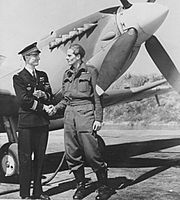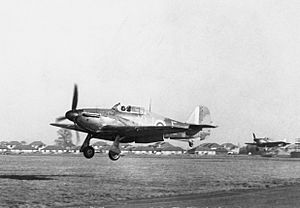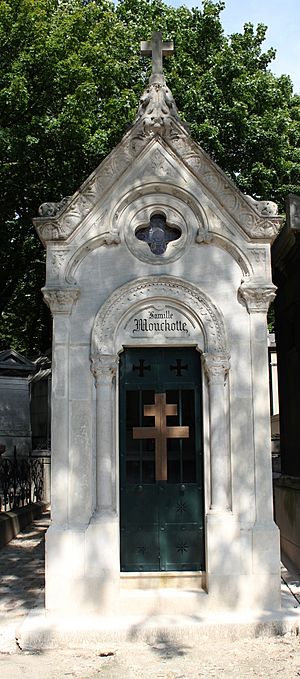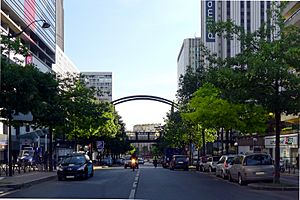René Mouchotte facts for kids
Quick facts for kids
René Mouchotte
|
|
|---|---|

René Mouchotte and Sqn Ldr "Jack" Charles at RAF Biggin Hill in May 1943
|
|
| Born | 21 August 1914 Paris, France |
| Died | 27 August 1943 (aged 29) Pas de Calais, France |
| Buried |
Père Lachaise Cemetery, Paris
|
| Allegiance | |
| Service/ |
|
| Years of service | 1935–1939 1939–1943 |
| Rank | Commandant and Squadron Leader |
| Unit | Escadrille « Versailles » No. 615 Squadron RAF No. 341 Squadron RAF No. 340 Squadron RAF |
| Battles/wars | World War II |
| Awards | Chevalier de la Légion d'honneur Compagnon de la Libération Croix de guerre 1939-1945 (6 palmes) Distinguished Flying Cross |
René Mouchotte (born August 21, 1914 – died August 27, 1943) was a brave pilot during World War II. He was part of the French Air Force. When France was partly controlled by a government called Vichy France, René made a daring escape from Oran to join the Free French Forces. These forces continued to fight against the enemy. He flew for the RAF and even led a group of fighter planes. Sadly, he was shot down and died in August 1943.
Contents
Early Life and Military Service
René Mouchotte was born in Paris, France, on August 21, 1914. His family was quite wealthy. He started his military career in the French Air Force in October 1935. This was at a place called Istres.
He quickly moved up in rank. By April 1937, he was a sergeant. He also became a qualified pilot in February 1937. In January 1939, he left the military for a short time. He went back to his normal life.
Joining the Fight
When World War II began in September 1939, René was called back to serve. He became a flying instructor at places like Salon-de-Provence. He really wanted to join a fighter squadron. But instead, he was sent to Oran in May 1940. There, he was supposed to learn to fly bigger, twin-engined planes.
After France signed an agreement to stop fighting, called the Armistice, pilots were told not to join the Free French forces. Their planes were even guarded by soldiers. But René Mouchotte and five friends decided to escape anyway. They took a twin-engined plane called a Caudron C.440 Goéland.
The plane's controls for its propellers were broken, making it very hard to take off. But they managed it! They landed safely in Gibraltar. From there, they traveled to England on a ship called Président Houduce.
Flying for Britain
Once in Britain, René Mouchotte trained on Hawker Hurricane planes. He then joined No. 615 Squadron RAF in northwest London. His first combat flight was on October 11, 1940.
His squadron moved to RAF Kenley in December 1940. In August 1941, he helped shoot down a German Junkers 88 plane. In November 1941, he moved to RAF Turnhouse. Here, the Free French No. 340 Squadron RAF was training on Spitfires. He became a flight commander in February 1942.
Leading a Squadron
On August 31, 1942, René Mouchotte was given command of No. 65 Squadron RAF. This was a very important moment. He was the first officer who was not from Britain or a Commonwealth country to lead an RAF squadron.
He was awarded the Distinguished Flying Cross on September 1, 1942. This award is given for bravery in air operations.
Later, he took command of No. 341 Squadron RAF. This squadron was part of the Biggin Hill Wing. On May 15, 1943, René Mouchotte and another pilot, S/L 'Jack' Charles, each destroyed a German Fw 190 plane. These were the 999th and 1,000th planes claimed by the Biggin Hill Wing.
Final Flight
On August 27, 1943, René Mouchotte was flying with Flying Fortresses. They were on a mission to attack a target in Pas de Calais, France. During this mission, his squadron was attacked by German Fw 190 planes.
The fight was intense, and his squadron got separated. René Mouchotte was last heard saying over the radio, "I am alone with the bombers." After that, no one saw or heard from him again. His body was found on September 3 and buried in Belgium.
After the war, in 1949, his body was moved back to Paris. He was buried in the family tomb at Père Lachaise Cemetery on November 3. A special ceremony with full military honors was held for him.
René Mouchotte flew a total of 1,748 hours. This included 408 hours in combat, flying 382 war missions. He was credited with destroying two enemy aircraft.
Remembering René Mouchotte
After the war, René Mouchotte's diaries and flight logs were made into a book. It was first published in France in 1949. Later, it was translated into English in 1956 and called The Mouchotte Diaries. This book became very popular.
Honoring His Name
In Paris, a street called Rue du Commandant Rene Mouchotte is named after him. There is also a nearby footbridge over the River Seine that carries his name. Two plaques in his memory can be found at Eperlecques.
A French Air Force base at Cambrai-Épinoy was named "Commandant René Mouchotte" in his honor. Even though that base is no longer active, another training base at Cazaux was named after him in September 2012.
In London, at the Lycée Français Charles de Gaulle, a special display was set up in June 2013. It honors Commandant René Mouchotte and the Free French Air Forces. The RAF headquarters in Gibraltar was also renamed the Mouchotte Building in September 2013.
René Mouchotte's story was even featured on a BBC One television show in January 2013. His British war medals, including one for the Battle of Britain, were given to his family in 2012.




